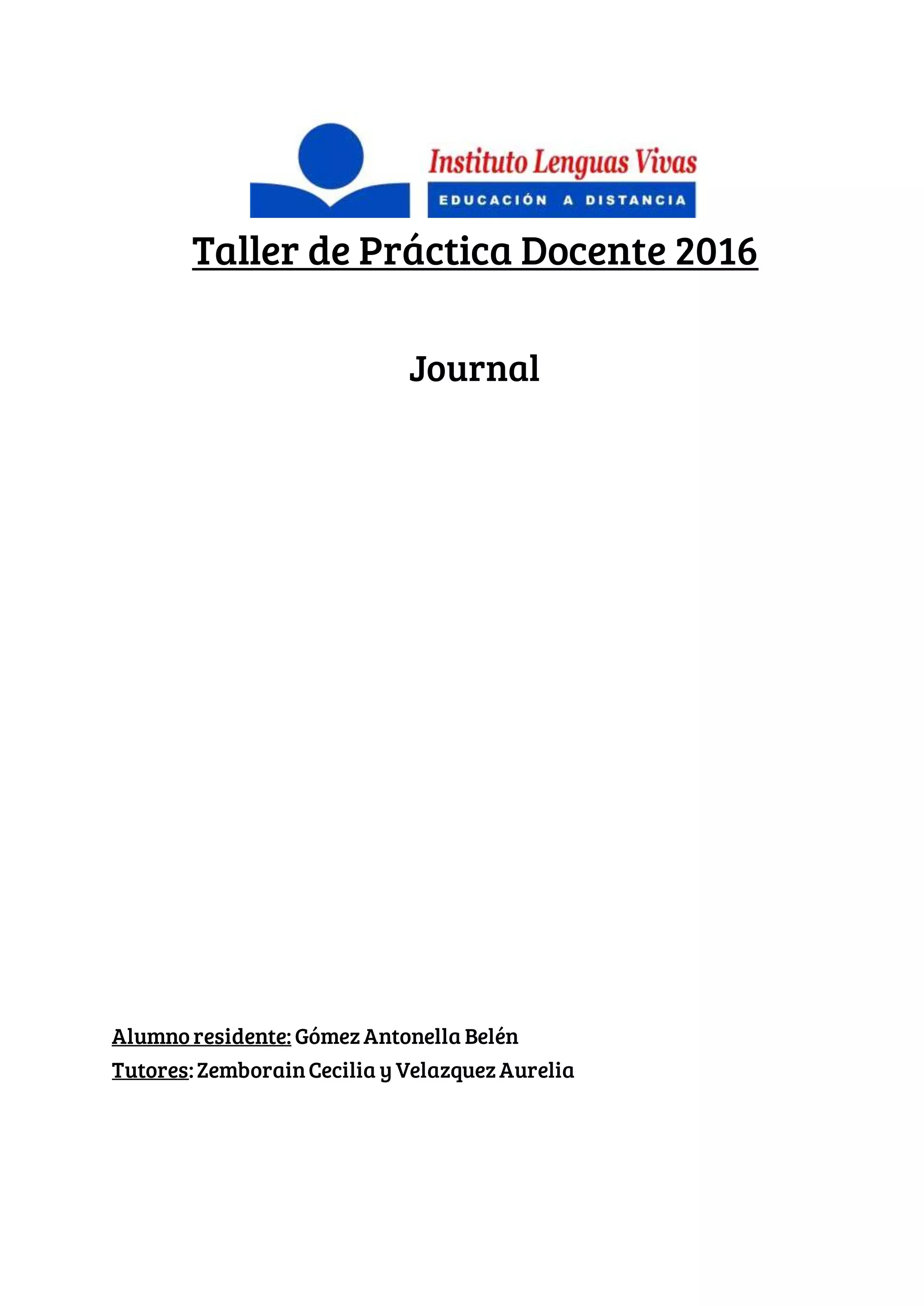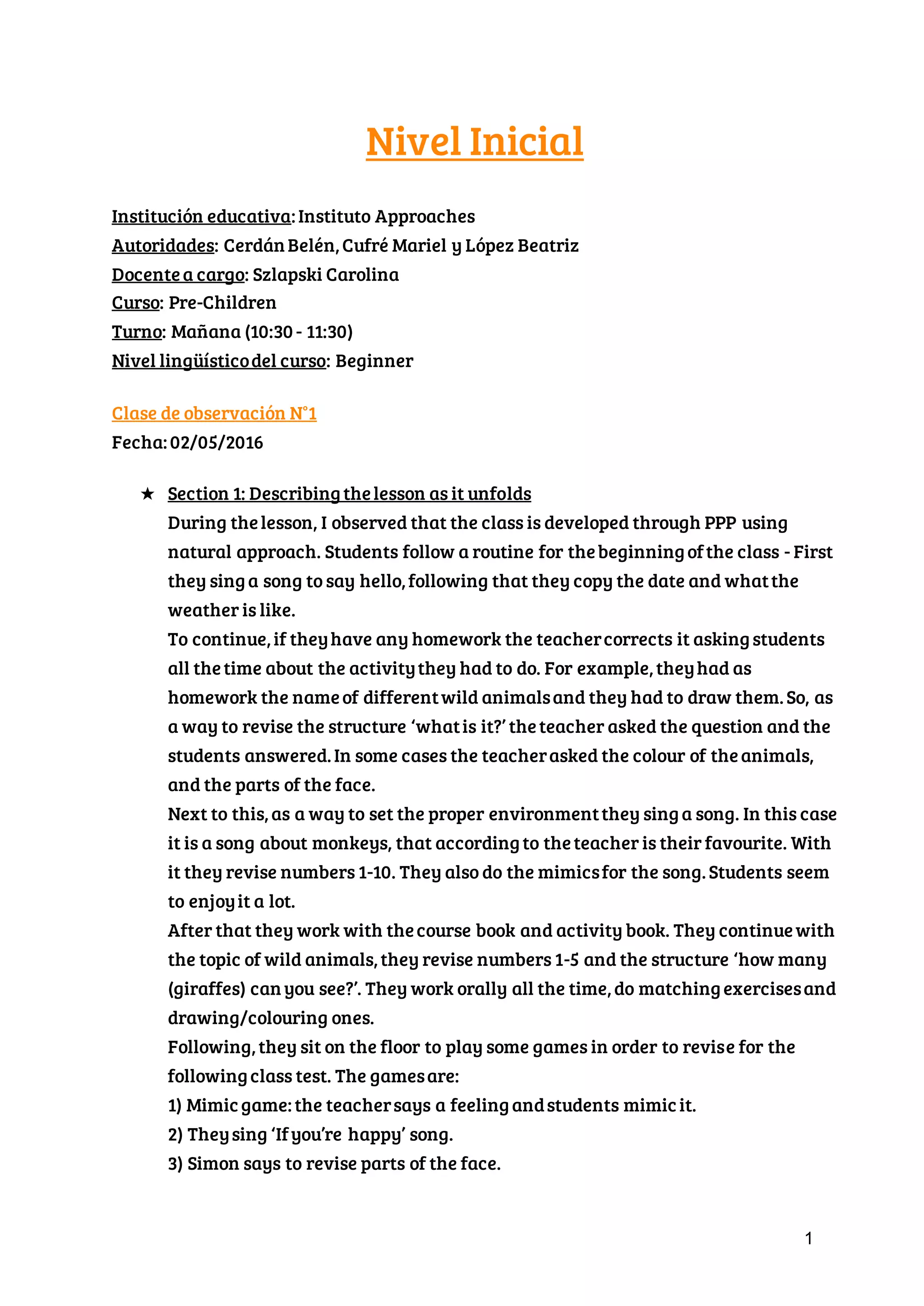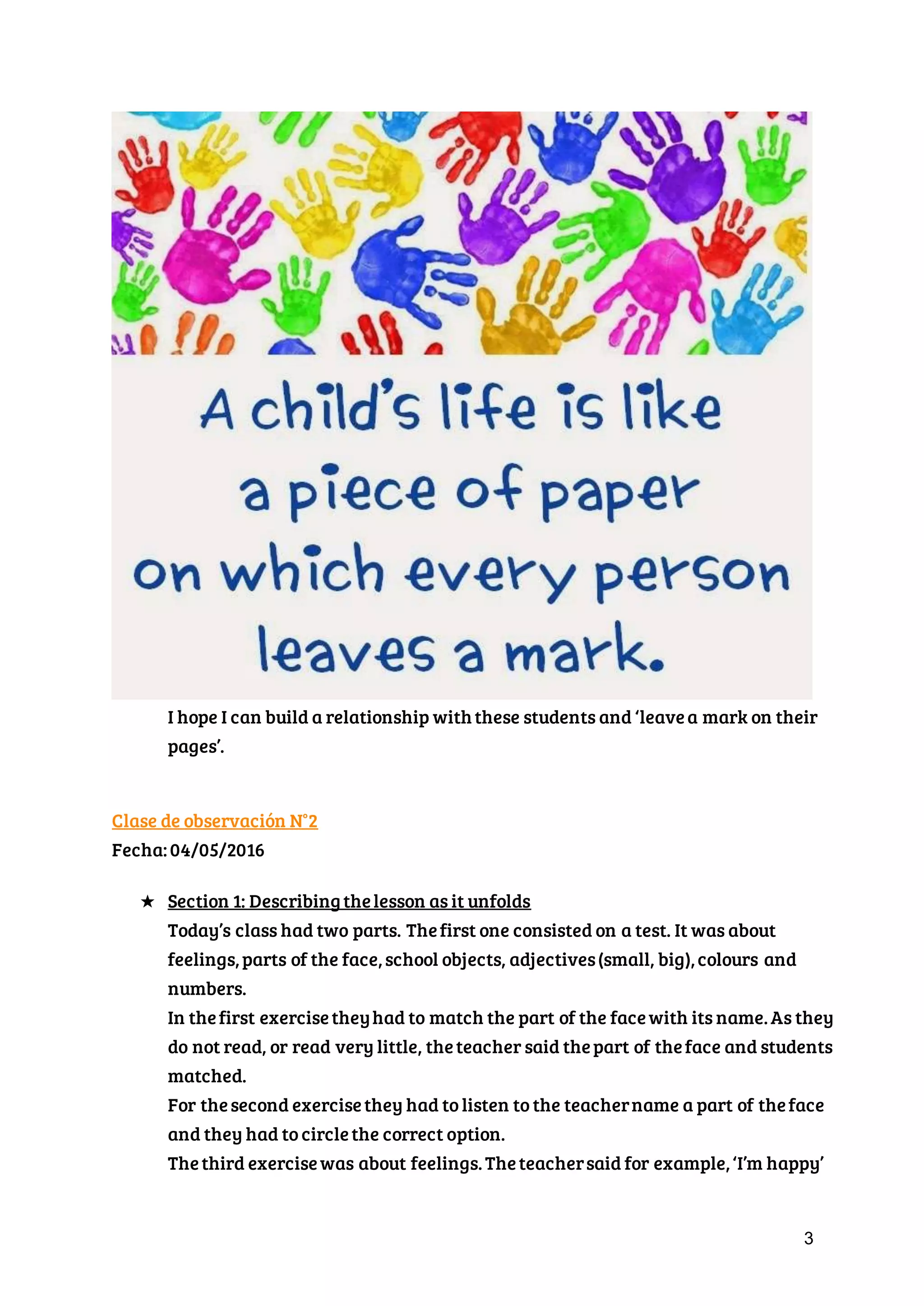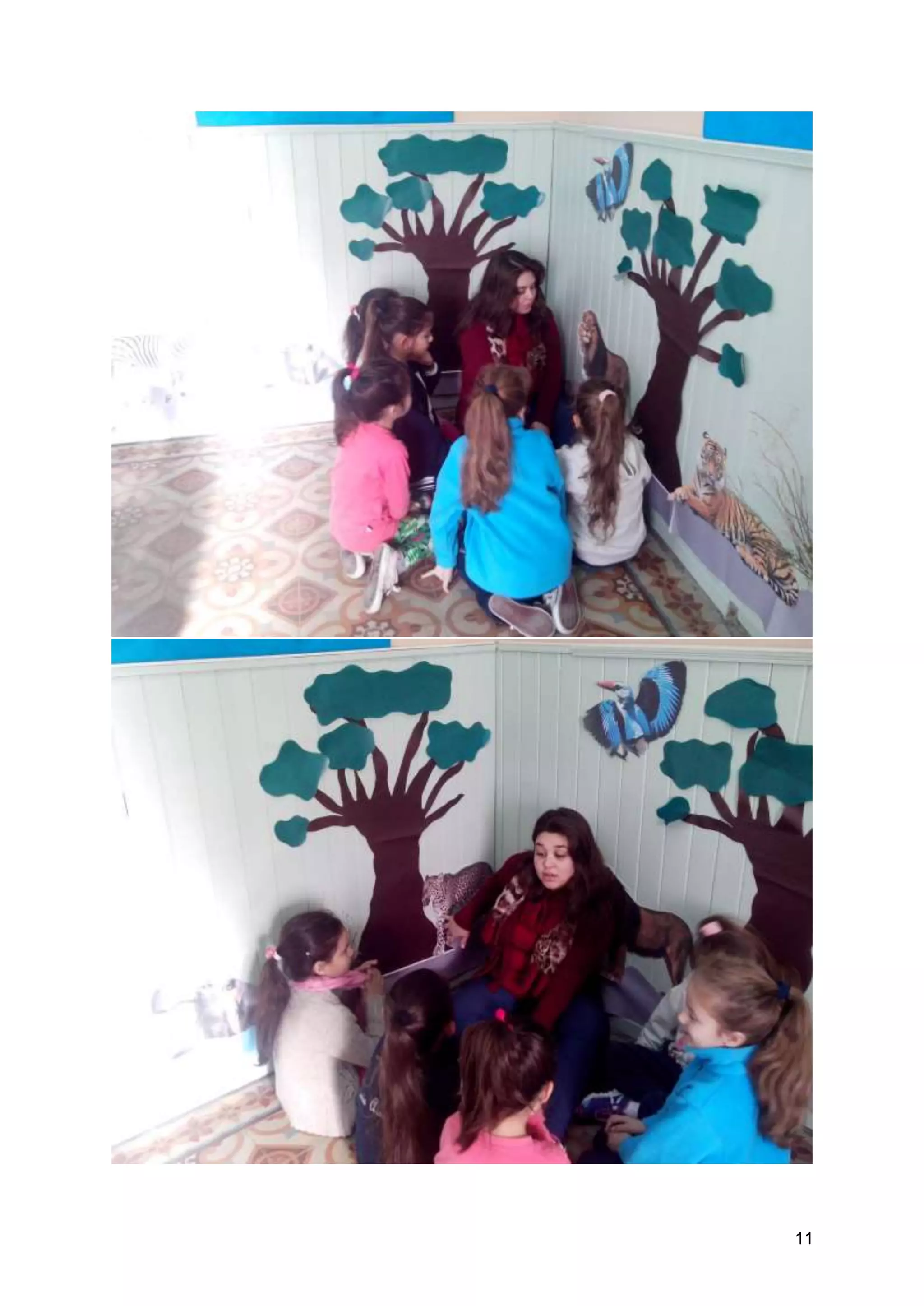The document summarizes journal entries from an observation of teaching lessons at an elementary school in Argentina. In the first lesson, the observer notes that the teacher uses a PPP approach and natural language teaching. Activities include singing, reviewing homework, games to practice vocabulary. Students seem engaged. In the second lesson, the observer assists with activities and tests. Students warmly say goodbye. In the third lesson taught by the observer, activities go well at first but students get bored with exercises from the book. However, they tell the teacher they enjoyed the class.


![2
4) Searching game: The teacher names a school object and students search
for it.
Finally, when they have finished, the teacher asks them to pack up and
they play a final game (Chinese whispers) to revise the animals learnt.
The teacher uses a lot of modeling, eliciting, miming and pointing during
the lesson, and also some translation. Students seem to respond very well
to her way of teaching and they are very comfortable with her. She has
managed to build a good rapport with students and create a comfortable
classroom environment.
I liked the way in which she invited students to speak in English. Whenever
a student asked for something in Spanish she said ‘How do you say it in
English?’ so the student had to ask in English for the teacher to give them
what they wanted. And they responded well to this, since sometimes they
said it in Spanish not because they didn’t know it, but because it is easier.
I also observed the dynamics of the lesson. Everything is very fast and very
varied, always following a topic. They have to be in constant movement
and varying from a quiet activity to a stirring one so that they do not get
bored.
★ Section 2: Making sense of the lesson through relevant lived experiences.
In my case, I greeted students at the beginning of the class and the teacher
introduced me. Students do not seem to like the idea of another ‘teacher’
around at first, but then they smiled at me and asked some questions. I
liked this because it helped me to start building up a connection with them.
As for a moment that was important for students as regards me, it was
when I offer to collect the notebooks the teacher was asking them. They
noticed that I remembered their names and they seemed to like it.
Sometimes is really hard to learn all their names quickly, but for them is
very important.
★ Section 3: Interpreting the lesson in words and images
I decided to choose a quote as to reflect this lesson:
Comentado [1]: This is something you should bear in
mind when designing the activities!
Comentado [2]: Yes, totally.
Comentado [3]: Definitely! It means recognising them
as individuals.](https://image.slidesharecdn.com/tpd-journal-inicial-160516174535/75/Tpd-journal-inicial-3-2048.jpg)



![6
were and their colours. Then I played the song, in which they had to listen
and guess the animal.
Following this I made-up some riddles, which were about colours of an
animal and they had to guess what the animal was. I tried to encourage
them to make a riddle for their classmates but none of them wanted.
Next, again listening to the CD, they had to listen to a description and tick
the correct animal.
At this stage they were already tired of the book and they were getting
bored. So, as we had 10 minutes left I decided to leave the last exercise and
skip directly to the closure game. Here they were happy again. We played
chinese whispers, and they enjoyed it.
When all of them had had the chance to participate I told them to pack up,
and we said goodbye to each other.
★ Section 2: Making sense of the lesson through relevant lived experiences.
As I said above, the lesson was quite good but I’m not satisfied. I didn’t like
the development part. The didn’t like the activities and they got bored. At
this part I felt quite nervous, since it was not what I expected. But at the end
of the class before they left, the teacher asked them if they had liked the
class and me, and they happily answered ‘yes’. They all came and kissed me
goodbye, and I felt a lot better. This was very important for me, because I
was not feeling as confident as I was at the beginning.
I also give some credit myself, since it was the first time I worked with little
children. I have no experience with those ages and I consider myself not
being too good with little children. As I would say in Spanish ‘no tengo
pasta’.
Comentado [4]: You have mentioned that the students
are quite fidgety. So, working with the book for a long
time was probably quite tedious for them.
Comentado [5]: It is a question of experience! Relax!](https://image.slidesharecdn.com/tpd-journal-inicial-160516174535/75/Tpd-journal-inicial-7-2048.jpg)
![7
★ Section 3: Interpreting the lesson in words and images
I have chosen this image because it describes how I saw the students at one
part of the class.
I hope I can do better next time and feel better with myself.
Clase de práctica N°2
Fecha: 11/05/2016
★ Section 1: Describing the lesson as it unfolds
This time, the girls were less willing to start the class. So it was a bit more
difficult for me to start the class.
The warm-up exercise, in which they had to listen to me and draw and
colour an animal, took longer than I expected, and I didn’t realize to change
it when we were by the second animal.
As for the presentation exercise, it was ‘Simon says’ game. They enjoyed it a
lot. They like all kinds of games in which they have to move around the
class.
Following this we sat on the floor for the pre-listening exercise and the
story. They didn’t like the pre-listening, which were some questions about
the pictures so as to brainstorm. But they enjoyed the story and they
answered correctly to the while listening task, which was to find out if the
elephant was happy.
To continue with the story and the topic of animals, they had to look for the
hidden animals in four pictures. They did it quickly, and as I passed to
Comentado [6]: The important thing is that you are
learning a lot. Take this as useful input to redesign your
lessons.](https://image.slidesharecdn.com/tpd-journal-inicial-160516174535/75/Tpd-journal-inicial-8-2048.jpg)
![8
correct the exercise I asked them ‘what animal is it?’ They answered
correctly.
Finally, as the last exercise we played ‘bingo’. It was a bit hard for them to
understand what they had to do, so I had to explain it to them in Spanish.
They liked it, but I think that it would have been a good idea to prepare
different bingo sheets, so that they didn’t spend so much time thinking and
drawing.
As I ran out of time I myself copy the homework on their notebooks.
★ Section 2: Making sense of the lesson through relevant lived experiences.
I felt that this time was a bit better than last class. They kept asking me to
play ‘chinese whispers’ and if they could sit next to me to play. Maybe I
should have cut out an activity to play it with them, since then I realized
that sometimes it is not always following the plan but to adjust to students
likes, too.
They left the classroom happy, and it was important for me.
★ Section 3: Interpreting the lesson in words and images
I think that this is the clue, what all this is about; learning together. As I
teach them, they teach me.
Comentado [7]: Definitely!
Comentado [8]: :)](https://image.slidesharecdn.com/tpd-journal-inicial-160516174535/75/Tpd-journal-inicial-9-2048.jpg)





![14
Comentado [9]: Beautiful!](https://image.slidesharecdn.com/tpd-journal-inicial-160516174535/75/Tpd-journal-inicial-15-2048.jpg)